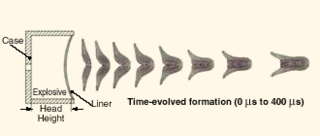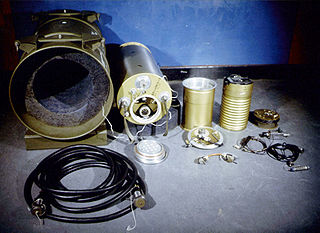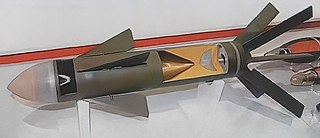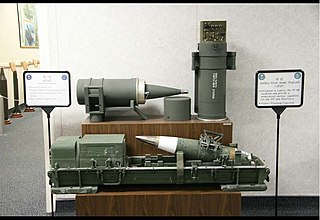Related Research Articles

A shaped charge is an explosive charge shaped to focus the effect of the explosive's energy. Different types of shaped charges are used for various purposes such as cutting and forming metal, initiating nuclear weapons, penetrating armor, or perforating wells in the oil and gas industry.

Alliant Techsystems Inc. (ATK) was an American aerospace, defense, and sporting goods company with its headquarters in Arlington County, Virginia, in the United States. The company operated in 22 states, Puerto Rico, and other countries. ATK's revenue in the 2014 fiscal year was about US$4.78 billion.
Insensitive munitions are munitions that are designed to withstand stimuli representative of severe but credible accidents. The current range of stimuli are shock, heat and adjacent detonating munitions. A munition can have its vulnerability reduced by a number of means used on their own or in combination such as a reduced vulnerability energetic material, design features, additions or changes to packaging etc. The munition must still retain its terminal effect and performance within acceptable parameters.

The Aerojet Rocketdyne RS-68 is a liquid-fuel rocket engine that uses liquid hydrogen (LH2) and liquid oxygen (LOX) as propellants in a gas-generator power cycle. It is the largest hydrogen-fueled rocket engine ever flown.
Thiokol was an American corporation concerned initially with rubber and related chemicals, and later with rocket and missile propulsion systems. Its name is a portmanteau of the Greek words for sulfur and glue, an allusion to the company's initial product, Thiokol polymer.

Originally known as the LAAAS, the JP233 is a British submunition delivery system consisting of large dispenser pods carrying several hundred submunitions designed to attack runways.

Medium Atomic Demolition Munition (MADM) was a tactical nuclear weapon developed by the United States during the Cold War. It was an Atomic demolition munition, a combat engineering device for demolition of structures and for battlefield shaping. The device contained W45 warhead, with an estimated yield of 0.5 to 15 kilotonnes of TNT. Each MADM weighed 391 pounds (177 kg) in its transportation container. They were deployed between 1962 and 1986.

An explosively formed penetrator (EFP), also known as an explosively formed projectile, a self-forging warhead, or a self-forging fragment, is a special type of shaped charge designed to penetrate armor effectively. As the name suggests, the effect of the explosive charge is to deform a metal plate into a slug or rod shape and accelerate it toward a target. They were first developed as oil well perforators by American oil companies in the 1930s, and were deployed as weapons in World War II.

The W45 was a multipurpose American nuclear warhead developed in the early 1960s, first built in 1962 and fielded in some applications until 1988. It had a diameter of 11.5 inches, a length of 27 inches and weighed 150 pounds. The yields of different W45 versions were 0.5, 1, 5, 8, 10, and 15 kilotons. The W45 was designed at the Livermore branch of the University of California Radiation Laboratory (UCRL), now Lawrence Livermore National Laboratory.

The XM395 Precision Guided Mortar Munition (PGMM) is a 120 mm guided mortar round developed by Alliant Techsystems.

Allegany Ballistics Laboratory (ABL) located in Rocket Center, West Virginia, is a diverse industrial complex employing some 1,000 people across 1,628 acres (6.59 km2). The facility is a member of the Federal Laboratory Consortium and is operated by Northrop Grumman under contract with the Naval Sea Systems Command (NAVSEA).

The Korean Smart Top-Attack Munition (KSTAM) is a smart munition intended to be launched from the gun of a main battle tank, namely the South Korean K2 Black Panther. Comparable systems include Diehl Corporation's Spear, DRDO SAMHO, CMI Defence and Luch Falarick 120, Israeli Aerospace Industries LAHAT, Nexter Systems Polynege, Alliant Techsystems STAFF and MRM-KE, Raytheon Technologies MRM-CE, and the two final companies' TERM.

The Castor family of solid-fuel rocket stages and boosters built by Thiokol and used on a variety of launch vehicles. They were initially developed as the second-stage motor of the Scout rocket. The design was based on the MGM-29 Sergeant, a surface-to-surface missile developed for the United States Army at the Jet Propulsion Laboratory.

The M1156 Precision Guidance Kit, formerly XM1156, is a U.S. Army-designed precision guidance system to turn existing 155 mm artillery shells into smart weapons. The prime contractor was Alliant Techsystems – later merging with Orbital Sciences Corporation to form Orbital ATK, in turn being taken over by Northrop Grumman and renamed Northrop Grumman Innovation Systems – and the industry team includes Interstate Electronics Corporation. By April 2018, more than 25,000 PGKs had been produced.

The W82 was a low-yield tactical nuclear warhead developed by the United States and designed to be used in a 155 mm artillery shell. It was conceived as a more flexible replacement for the W48, the previous generation of 155 mm nuclear artillery shell. A previous attempt to replace the W48 with the W74 munition was canceled due to cost.
The M141 Bunker Defeat Munition (BDM), or SMAW-D ("Disposable"), is a single-shot, shoulder-launched weapon designed to defeat hardened structures. The weapon was designed as a modification of the United States Marine Corps Shoulder-launched Multipurpose Assault Weapon (SMAW) to fill the void in the United States Army inventory of a "bunker buster" weapon.

Swales Aerospace was an employee-owned, small business aerospace engineering firm. The company offered a full range of aerospace engineering services. It was the global leader in the development and manufacture of two-phase thermal solutions for spaceflight applications, and it was a small satellite mission provider. In 2007, it was acquired by Alliant Techsystems.
The M7 Spider is a networked United States anti-personnel munitions system that provides a secure remote command and control capability of up to 1500 meters for a hand-emplaced munition field. The system was developed by Alliant Techsystems (ATK) with its joint venture partner Textron Systems as a part of the Non-Self-Destruct Alternative (NSD-A) program and is intended to replace the Matrix remote trigger system currently deployed in Iraq which works with pre-existing mines like the M18 Claymore. Day & Zimmermann and General Dynamics are prime subcontractors.
Sheet explosives are materials formed by combining an explosive with a "rubberizer"—a flexible binding agent. The resulting compound is cast into a flat sheet which is typically pliable and deformable over a wide range of temperature. Typical products are generally shock-insensitive secondary explosives, requiring a blasting cap or other detonator.
Northrop Grumman Innovation Systems (NGIS) was a sector of Northrop Grumman from 2018 through 2019. It was formed out of Orbital ATK Inc. a company which resulted from the merger of Orbital Sciences Corporation and parts of Alliant Techsystems in 2015. Orbital ATK was purchased by Northrop Grumman in 2018. Northrop Grumman Innovation Systems designed, built, and delivered space, defense, and aviation-related systems to customers around the world both as a prime contractor and as a merchant supplier. It had a workforce of approximately 12,000 employees dedicated to aerospace and defense including about 4,000 engineers and scientists; 7,000 manufacturing and operations specialists; and 1,000 management and administration personnel. With Northrop Grumman's reorganization of its divisions effective 1 January 2020, NGIS was split, with most of the sector merging with other Northrop Grumman businesses into a new Space Systems sector.